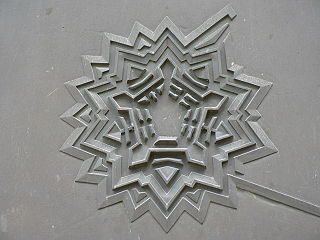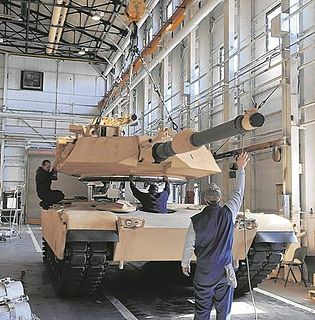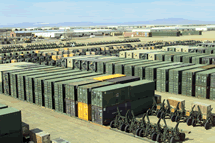Related Research Articles

The Defense Forces of Georgia, or Georgian Defense Forces, known as the Georgian Armed Forces until December 2018, are the combined military forces of Georgia, tasked with the defense of the nation’s independence, sovereignty, and territorial integrity. They consist of the Land Force, Air Force, National Guard, and Special Operations Forces. The Defense Forces are under overall leadership of the Minister of Defense of Georgia and directly headed by the Chief of Defense Forces.

The Kuwait Military Forces consists of several joint forming defense forces. The governing bodies are the Kuwait Ministry of Defense, the Kuwait Ministry of Interior, the Kuwait National Guard and the Kuwait Fire Service Directorate. The Emir of Kuwait is the commander-in-chief of all defense forces and the Crown Prince is the deputy commander.

The Army of the Republic of North Macedonia is a defense force consisting of an army and air force; it is responsible for defending the sovereignty and territorial integrity of North Macedonia. Since 2005, it is a fully professional defense force compatible with NATO standards.

The Heavy Expanded Mobility Tactical Truck (HEMTT) is an eight-wheel drive, diesel-powered, 10-short-ton (9,100 kg), tactical truck used by the US military and others. In evolving configurations, it has been in continuous production since 1982. The M977 HEMTT entered service with the U.S. Army as a replacement for the M520 Goer.

Heavy Equipment Transporter is a term applied (primarily) to a U.S. Army logistics vehicle transport system, the primary purpose of which is to transport the M1 Abrams tank. It is also used to transport, deploy, and evacuate armored personnel carriers, self-propelled artillery, armored bulldozers, and other heavy vehicles and equipment of all types.

A military is a heavily armed, highly organised force primarily intended for warfare, also known collectively as armed forces. It is typically officially authorized and maintained by a sovereign state, with its members identifiable by their distinct military uniform. It may consist of one or more military branches such as an army, navy, air force, space force, marines, or coast guard. The main task of the military is usually defined as defence of the state and its interests against external armed threats.

Military engineering is loosely defined as the art, science, and practice of designing and building military works and maintaining lines of military transport and military communications. Military engineers are also responsible for logistics behind military tactics. Modern military engineering differs from civil engineering. In the 20th and 21st centuries, military engineering also includes other engineering disciplines such as mechanical and electrical engineering techniques.

The Gulf War, codenamed Operation Desert Shield for operations leading to the buildup of troops and defense of Saudi Arabia and Operation Desert Storm in its combat phase, was a war waged by coalition forces from 35 nations led by the United States against Iraq in response to Iraq's invasion and annexation of Kuwait arising from oil pricing and production disputes. The war is also known under other names, such as the Persian Gulf War, First Gulf War, Gulf War I, Kuwait War, First Iraq War or Iraq War, before the term "Iraq War" became identified instead with the post-2003 Iraq War. The war has also earned the nickname Video Game War after the daily broadcast of images from cameras on board US bombers during Operation Desert Storm.

In NATO and most other western countries, motorized infantry is infantry that is transported by trucks or other motor vehicles. It is distinguished from mechanized infantry, which is carried in armoured personnel carriers or infantry fighting vehicles, and from light infantry, which can typically operate autonomously from supporting elements and vehicles for relatively long periods and may be airborne.

The Iraqi Army, officially the Iraqi Ground Forces, is the ground force component of the Iraqi Armed Forces, having been active in various incarnations throughout the 20th and 21st centuries. It was known as the Royal Iraqi Army up until the coup of July 1958.

Anniston Army Depot (ANAD) is a major United States Army facility for the production and repair of ground combat vehicles, overhaul of Small Arms Weapon Systems and the storage of chemical weapons, a.k.a. the Anniston Chemical Activity. The depot is located in Bynum, Alabama.
Letterkenny Army Depot , the Center of Industrial and Technical Excellence (CITE) for Air Defense and Tactical Missile Systems, was established in 1942. The Depot is under the command structure of the U.S. Army Aviation and Missile Command (AMCOM). The facilities at Letterkenny are used to conduct maintenance, modification, storage, and demilitarization operations on tactical missiles and ammunition.

The Palletized Load System (PLS) is a truck-based logistics system that entered service in the United States Army in 1993. It performs line haul, local haul, unit resupply, and other missions in the tactical environment to support modernized and highly mobile combat units. It provides rapid movement of combat configured loads of ammunition and all classes of supply, shelters and containers. It mirrors similar systems in use with the British and other armed forces.

The Iraqi Armed Forces are the military forces of the Republic of Iraq. They consist of the Iraqi Army, the Iraqi Air Force, and the Iraqi Navy.

The Royal Jordanian Army is part of the Jordanian Armed Forces (JAF). It draws its origins from units such as the Arab Legion, formed in the British Mandate of Transjordan in the 1920s. It has seen combat against Israel in 1948, 1956, 1967, and 1973. The Army also fought the Syrians and the PLO during Black September in 1970.
The following is a partial accounting of financial costs of the 2003 Iraq War by the United States and the United Kingdom, the two largest non-Iraqi participants of the multinational force in Iraq.
Strategic reset was a policy framework designed to stop counterproductive U.S. engagement in a fragmenting Iraq and to strengthen the United States' stance throughout the Middle East. In military terms, "reset" refers to "a series of actions to restore units to a desired level of combat capability commensurate with future mission requirements."

The 593rd Expeditionary Sustainment Command is a Sustainment Command of the United States Army.

The logistics specialist (LS) is a US Navy enlisted rating that was created on 1 October 2009 by the merger of the storekeeper (SK) and postal clerk (PC) ratings. It also includes the previous functions of the former aviation storekeeper (AK) rating, which was previously merged into the former storekeeper (SK) rating on 1 January 2003.

Sierra Army Depot (SIAD) is a United States Army post and military equipment storage facility located near the unincorporated community of Herlong, California. It was built in 1942 as one of several ammunition storage facilities located far enough inland to be safe from Japanese attack. The site also met the requirement that the depot be in a dry and isolated area.
References
| Look up reset in Wiktionary, the free dictionary. |
- Dinklage, Lindy. "Army Launches Reset Pilot," Army News Service. February 22, 2008.
- Lenaers, William M. and Brent D. Coryell. "Reset: Extending the Life of Army Equipment," Army Logistician. Vol. 38, No. 1. January-February 2006.